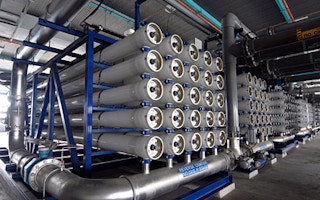Singapore will be able to meet its water requirements independently ahead of the 2061 expiration of a century-long supply agreement with Malaysia “if need be,” the head of the city-state’s water utility said.
Desalination and recycling plants produce 40 percent of the 380 million British gallons (456 million US gallons) of water companies in Singapore and its 5.2 million population use daily, Chew Men Leong, chief executive of PUB, said in an interview on July 27. A downtown dam adds a further 10 percent, with the remaining coming from its reservoirs and imports from Malaysia.
“We have made progress to the point that we are now much more confident in terms of water security and sustainability,” said Chew, 44, a former naval chief who joined the utility about a year ago. “If you’re asking me this question about when will we ever get self-sufficiency, I will put it this way that we can be self-sufficient if need be.”
Singapore, which relied on Malaysia for its water needs, spent S$600 million ($481 million) to S$800 million a year since 2006 on new technologies to boost its supply. The push to develop the industry has drawn businesses including General Electric and Siemens to invest, and created local water companies such as Hyflux that have expanded overseas.
“What they are looking to do is create a virtual market for the water business which is much larger than Singapore,” said Glen Daigger, chief technology officer of CH2M Hill, an Englewood, Colorado-based industry consulting firm. “By becoming a thought leader for water in Asia, then they really create a market which is orders of magnitude bigger than Singapore itself.”
Rising demand
The island that’s almost half the size of the city of Los Angeles is developing its water industry to meet the country’s requirement, which Chew expects will exceed 700 million gallons a day in 50 years. That’s equivalent to more than 1,000 Olympic- sized swimming pools, based on data from the US Environment Protection Agency.
Singapore has relied on Malaysia for its water supply, with the first of four contracts signed in 1927, according to data compiled by the city’s National Library. An agreement in 1961 expired last year while the remaining 1962 accord, which ends in 49 years, gives Singapore 250 million gallons of raw water daily.
Arguments over the water contracts had overshadowed relations between the two countries, which were briefly united in a federation from 1963 to 1965.
The water strategy “goes back to Lee Kuan Yew with respect to making sure that Singapore, which initially was reliant upon imported water from Malaysia, that it not be put in a position where it was not able to depend on that source as a reliable supply,” said Paul Brown, executive vice president of CDM Smith, referring to city-state’s first prime minister.
Downtown dam
CDM Smith, a Cambridge, Massachusetts infrastructure consulting company, designed the Marina Barrage, the dam in the island-state’s business district that was completed in 2010 and holds water from the Singapore River and the Marina Bay.
Water from rainfall and drawn through a 7,000-kilometer (4,350-mile) drainage network into more than a dozen reservoirs across Singapore will be supplemented by desalination, which treats seawater, and recycling systems, Chew said.
“Water is a priority area for Singapore, and this has set the tone and direction for water management in the country,” Olivia Lum, chief executive officer of Hyflux, the city’s biggest water company, said in an e-mailed response to queries.
Hyflux, whose sales quadrupled to S$534.1 million in the past year from 2006, developed the city’s first desalination plant and is building similar projects in China and Algeria.
Sustainable costs
Desalination plants produce 10 percent of water in Singapore, Chew said, which will increase to 30 percent in 50 years. The use of recycled water, known as NEWater, is mainly for industrial purposes such as cooling machines and factory processes, and will make up 50 percent of supply by 2061.
“We have essentially moved from a position of vulnerability to better security,” Chew said, adding that the goal is to make the supply “sustainable in terms of costs.”
Singapore has achieved more than half of its target of adding 11,000 jobs to the water industry by 2015 as the number of companies in the city doubled to 100 since 2006, PUB said. The city-state also hosted the Water Week conference and two related expositions earlier this month, drawing a record 19,200 participants. The events will be held every two years.
“Over the next five to six years, we are committed to increasing our technology and engineering presence leveraging the greater opportunities we have here in Singapore,” said Michael Roeder, regional commercial leader of engineered systems at General Electric (GE)’s water unit in the city-state.
Flushers, faucets
Chew said his main worry is climate change and how that lowers water levels at reservoirs. Changing weather patterns also led to heavy rainfalls and flash floods that added stress to its drainage systems, where parts of the Orchard Road shopping belt were affected over the past two years.
PUB is also working on reducing water consumption, he said, with measures ranging from mandatory dual-flushing systems for toilets and automatic faucets in all public restrooms.
The average usage per person is now 153.4 liters (40 US gallons) a day, down from 165 liters nine years ago, he said. That’s expected to fall to 147 liters by the end of the decade and 140 liters in the following 10 years, he said.
“Here, water is an issue of life and death,” Chew said. “That’s always been the message.”










